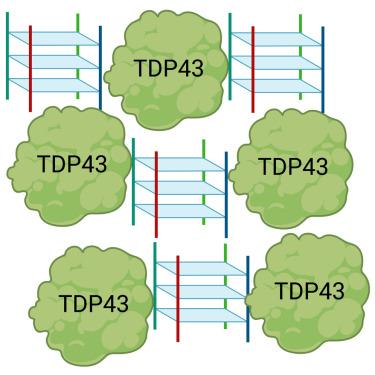The effect of G-quadruplexes on TDP43 condensation, distribution, and toxicity
IF 4.3
2区 生物学
Q2 BIOCHEMISTRY & MOLECULAR BIOLOGY
引用次数: 0
Abstract
Many proteins implicated in neurodegenerative diseases (e.g., trans-active response DNA binding protein 43 kDa [TDP43]) interact with nucleic acids, including RNA G-quadruplexes (G4s). We here investigate whether RNA G4s play a role in TDP43 condensation in biophysical and cellular models. We find that G4s modulate TDP43 aggregation in vitro and condensation in multiple cell types, including yeast, HEK293T, and motor-neuron-like NSC-34 cells. In yeast cells, treatment with G4s causes increased TDP43 accumulation in cells before cellular death. In HEK293T cells expressing TDP43, incubation with G4-binding small molecules causes an increase in G4 stability that also stabilizes TDP43 and reduces TDP43 condensation induced by proteasomal or oxidative stress. Finally, in NSC-34 cells overexpressing exogenous TDP43, we show that G4s co-localize with TDP43 condensates under stress conditions, and treatment with G4-binding small molecules decreases TDP43-mediated toxicity. Together, these findings suggest exploring treating protein misfolding diseases by targeting specific RNA structures such as G4s.

g -四聚物对TDP43缩聚、分布及毒性的影响
许多与神经退行性疾病相关的蛋白质(例如,反式反应DNA结合蛋白43 kDa [TDP43])与核酸相互作用,包括RNA g -四重复合物(G4s)。我们在此研究RNA G4s在生物物理和细胞模型中是否在TDP43缩聚中发挥作用。我们发现G4s在体外调节TDP43在多种细胞类型中的聚集和凝聚,包括酵母、HEK293T和运动神经元样NSC-34细胞。在酵母细胞中,G4s处理导致细胞死亡前TDP43积累增加。在表达TDP43的HEK293T细胞中,与G4结合的小分子孵化能提高G4的稳定性,从而稳定TDP43,减少由蛋白酶体或氧化应激引起的TDP43凝结。最后,在过表达外源性TDP43的NSC-34细胞中,我们发现G4s在应激条件下与TDP43凝聚物共定位,用g4结合的小分子处理可以降低TDP43介导的毒性。总之,这些发现提示通过靶向特定RNA结构(如G4s)来治疗蛋白质错误折叠疾病。
本文章由计算机程序翻译,如有差异,请以英文原文为准。
求助全文
约1分钟内获得全文
求助全文
来源期刊

Structure
生物-生化与分子生物学
CiteScore
8.90
自引率
1.80%
发文量
155
审稿时长
3-8 weeks
期刊介绍:
Structure aims to publish papers of exceptional interest in the field of structural biology. The journal strives to be essential reading for structural biologists, as well as biologists and biochemists that are interested in macromolecular structure and function. Structure strongly encourages the submission of manuscripts that present structural and molecular insights into biological function and mechanism. Other reports that address fundamental questions in structural biology, such as structure-based examinations of protein evolution, folding, and/or design, will also be considered. We will consider the application of any method, experimental or computational, at high or low resolution, to conduct structural investigations, as long as the method is appropriate for the biological, functional, and mechanistic question(s) being addressed. Likewise, reports describing single-molecule analysis of biological mechanisms are welcome.
In general, the editors encourage submission of experimental structural studies that are enriched by an analysis of structure-activity relationships and will not consider studies that solely report structural information unless the structure or analysis is of exceptional and broad interest. Studies reporting only homology models, de novo models, or molecular dynamics simulations are also discouraged unless the models are informed by or validated by novel experimental data; rationalization of a large body of existing experimental evidence and making testable predictions based on a model or simulation is often not considered sufficient.
 求助内容:
求助内容: 应助结果提醒方式:
应助结果提醒方式:


